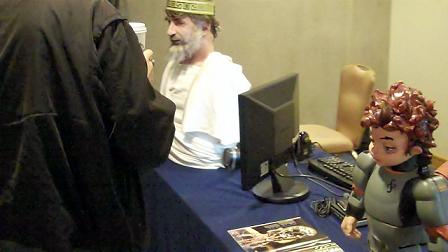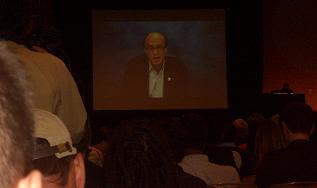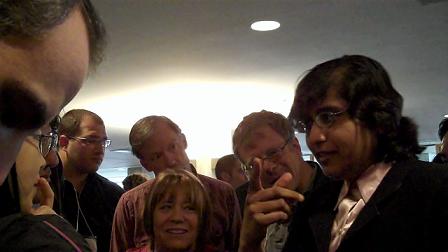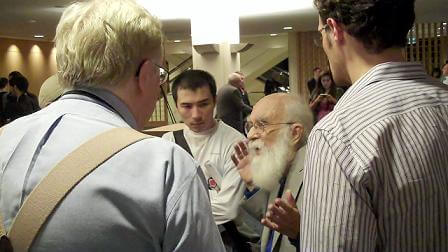Singularity Summit 2010: Optimism, Intelligence, the Future – Oh My
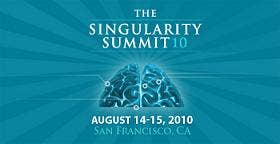
Share
The Singularity is near...it's at the Hyatt in San Francisco. This past weekend I saw some of the leading minds in accelerating technologies gather at the Singularity Summit. Now in its fifth year, the Summit acts as the premier forum for discussing the science that may launch us into an era when natural human intelligence is no longer the dominant force on the planet. The two days of the conference drew the usual crowd of futurists, scholars, and innovators including Singularity frontman Ray Kurzweil, AI guru Ben Goertzel, and robotics artist David Hanson. I was also pleased to see some newer faces like Irene Pepperberg, noted researcher in avian intelligence, and James Randi, perhaps the most famous and successful skeptic in the world (he's an amazing magician, too). Does it sound like fun? Oh hell yes, you have no idea. But don't worry if you missed it, I'll give you the short version of how it all went down.
The Singularity Summit is a weird beast. Part science lectures, part networking, part philosophical discussion it comes off as an enthusiastic collection of people who aren't afraid to think well outside the box. One attendee called it a comic con for those who prefer science to science fiction. Most of the day was consumed with lectures, but we were also treated to some neat demonstrations such as robots from David Hanson's workshop, and a delightful musical instrument (H2Organ) developed by Steven Mann that uses both electricity and water. Check it out:
There's no doubt that the core of the Summit was about science, and the core of that core was artificial intelligence. AI was on everyone's minds and in every presentation. Yet AI isn't always the easiest thing to discuss. You know it's going to be a fun conference when the smartest people in the room are also the ones that get called crazy on a regular basis. Talk about artificial intelligence with most people and you're likely to get one of two responses: "Won't robots want to kill all humans?" and "Yeah, we've been saying artificial intelligence is 15 years away for 60 years now." It doesn't come as a big surprise that most of the discussion about computer AI was relatively cautious and the focus was on hopes for developing paths towards reasonable successes.
Ben Goertzel, Demis Hassabis, Terrence Sejnowksi, David Hanson, and Shane Legg all discussed their work in artificial intelligence and while the details of those experiments were too intricate for the layman, their visions for the future of the science were often very accessible. Goertzel shared his recent collaborations with Genescient using AI to examine the genomes of fruit flies bred for incredible longevity (five times the normal). He thinks AI biologists are the key to understanding human genes and extending human life spans. Hassabis urged his fellow researchers to use neuroscience's insights into the brain to understand the basic algorithms intelligent beings use to think .Sejnowski thinks artificial systems with cognitive learning skills are going to let us improve efficiency in radio bandwidths, robotic highways, and the aging electric grid. Shane Legg developed an equation to objectively rate intelligence, so we might be able to realistically describe how far we're progressing in AI. Hanson wants to teach robots to act like us, and even want our love, so that we can teach them how to be moral before we give them the capabilities of gods. Any of these presentations could have merited a full weekend of discussion, but they were all dwarfed by the big draw at the Summit, Ray Kurzweil.
Kurzweil, who teleconferenced in for the event, has a stock presentation on the future. Exponential graphs describing the accelerating nature of technology (think Moore's law, but for almost everything) are the crux of the show. Thankfully, though, Kurzweil knew his audience has mostly seen it all before so he focused mainly on the human brain and the development of an artificial mind. This is also the topic of his upcoming book. The most memorable point Kurzweil made was rather refreshing for me to hear him say: consciousness may be too subjective to measure. Sure, the Turing Test may let you know whether we believe an AI to be conscious, but consciousness itself may be immune to objective testing. An interesting concession. Kurzweil also went into some cool details about how 'recognizer' units in the brain's cerebral cortex may handle pattern recognition by building simple lists that get crossed referenced. Just like the LISP programming language, if you're familiar with it. Each concept is described by a list of related concepts. From that simple premise you can develop all kinds of sophisticated views on the universe. All in all, Kurzweil gave one of the more interesting talks I've seen from him in years...it would have been even better had he been able to attend in person.
Along with AI presentations were discussion of what I simply think of as neat science. Where 'neat' could easily be replaced with 'mind-blowing'. Mandayam Srinivisan of MIT discussed haptic technologies, and the brain's ability to adapt to new stimuli. Deaf and blind individuals can learn how to understand normal speech by using their fingers to read lips and feel through vibrations (a technique called tadoma). Their brains start to use the visual and speech centers to process information from their sense of touch. Srinivisan tied that into his work with developing robotic devices that let you feel virtual objects. Imagine if your computer mouse gave you physical resistance whenever you tried to move a cursor through a line on your screen. Such haptic technologies may eventually let us 'feel' and manipulate nanoscale objects.
Surgeon Brian Litt discussed all sorts of brain computer interfaces and implants. He pointed out how little we know about how to connect electronics to nerve tissues and the surprises that the brain has yet to reveal. Did you know that your mind replays recent memories in the prefrontal cortex while you sleep? It does, and at high speeds, too. You get a rapid repetition of the skills you tried to develop during the day. Pretty cool.
As you might expect, there were plenty at the Summit who played cheerleader to the future, often with good reason. Ramez Naam reveled in the information we're about to learn as we begin to map the genomes of all the species on Earth. Jose Cordeiro gave us reason to relax about the energy crisis, explaining the abundance of solar power, the real possibilities of nuclear fusion, and how 'surprise sources' of power always arise. Lance Becker explained his work in extending the period during which you can be revived after fatal injury - "mostly dead is still partially alive". Ellen Haber-Katz, whose work we've discussed before, talked about how a strain of mouse (the MRL) had been raising hopes for regeneration of lost tissue in humans.
Be Part of the Future
Sign up to receive top stories about groundbreaking technologies and visionary thinkers from SingularityHub.


The chummy atmosphere of techno-optimism didn't give rise to much controversy, but a few tried to get some lively debate going. Anita Goel, who discussed her brilliant work fusing biology, physics, and information systems spent most of her time describing how natural molecular machines like DNA polymerase read and write our genetic code. But at the end of her talk she threw caution to the wind and tried to ask provocative questions. Do complexities in matter and energy give rise to intelligence or is it the other way around? Is intelligence a fundamental part of the universe just like energy and matter? Sure, we didn't actually come up with any answers, but the discussions in the halls afterward were quite fun.
Still, if there was one thing that this year's Summit was missing it was opposition. There wasn't a single speaker who really looked at the concept of the Singularity and cried bullsh*t. Sure, Dennis Bray warned that the complexities of biological systems would surprise us, and Irene Pepperberg cautioned researchers from manipulating non-human (animal) intelligence when we really know very little about how it works. But these scientists didn't challenge the idea of accelerating technology directly. No one really did. And while I firmly believe (at least on most days) that the Singularity will arise, I would have liked to have at least one curmudgeon rain on everyone's parade just to keep things interesting.
The closest we got were two healthy reminders to keep ourselves honest. Michael Vassar, president of the Singularity Institute that organizes the Summit, opened the first day with a presentation on the nature of science. I really hope to find this talk online at some point so I can share it with you. Vassar's insights into the history of science and its competitors in rational thought was nothing short of brilliant. It made me very conscious of the power of empiricism, and helped me question the systems we've built for knowing things.
Of course, the true double check on our sanity was performed by the grand pooh-ba of skepticism himself, James Randi. The Amazing Randi is a world class magician and mentalist as well as being at the forefront of examining (and unerringly disproving) paranormal claims. Through delightful anecdotes, magic tricks, and humor Randi pointed out the outrageous things we'll believe. He performed a feat of mentalism that proved he could read someone's mind to the great appreciation of the crowd. It was a fun presentation to say the least.
I've read a few tweets and blog posts that question the relevance of Randi's presentation. Fun, they say, but not really germane to the discussion on hand. I disagree. For Randi's tricks and stories conveyed one powerful observation: we can be easily fooled when we think about every situation through the lens or our own specialty. Accelerating technologies. Exponential graphs of computer processing power. Amazing developments in artificial intelligence. These are the focus of the Singularity Summit and of futurists the world over. They are powerful indicators of what humanity may accomplish in the years ahead, but we must be cautious not to see every development as further evidence of their truth. Technological optimism must be balanced by healthy skepticism, or we will blindly pursue pipe dreams while ignoring the arrival of greater benefits and dangers. That's the final lesson I took away from Singularity Summit 2010.
It was an amazing weekend. Hope to see you there next year.
[image credits: Singularity Institute, Aaron Saenz/Singularity Hub]
[video credits: Aaron Saenz/Singularity Hub]
Related Articles

New Gene Drive Stops the Spread of Malaria—Without Killing Any Mosquitoes

These Robots Are the Size of Single Cells and Cost Just a Penny Apiece

Hugging Face Says AI Models With Reasoning Use 30x More Energy on Average
What we’re reading

